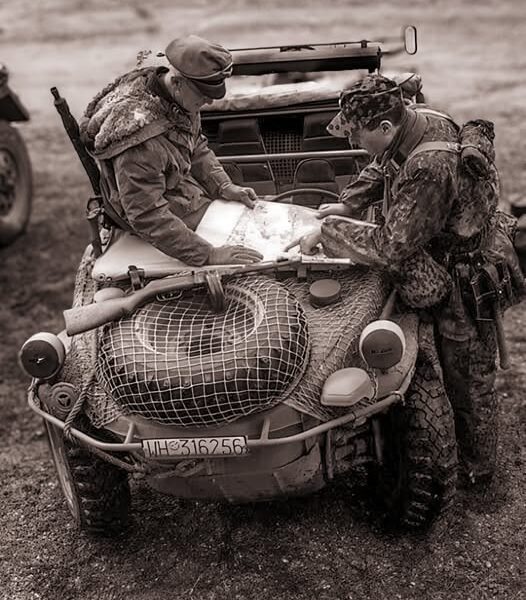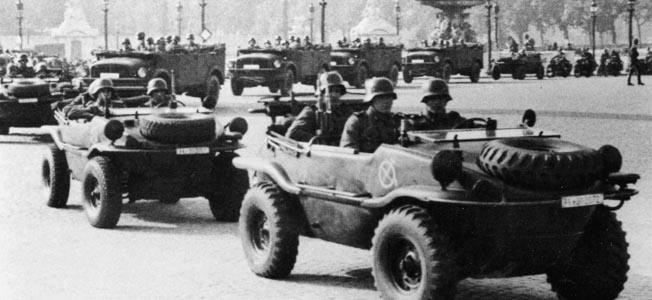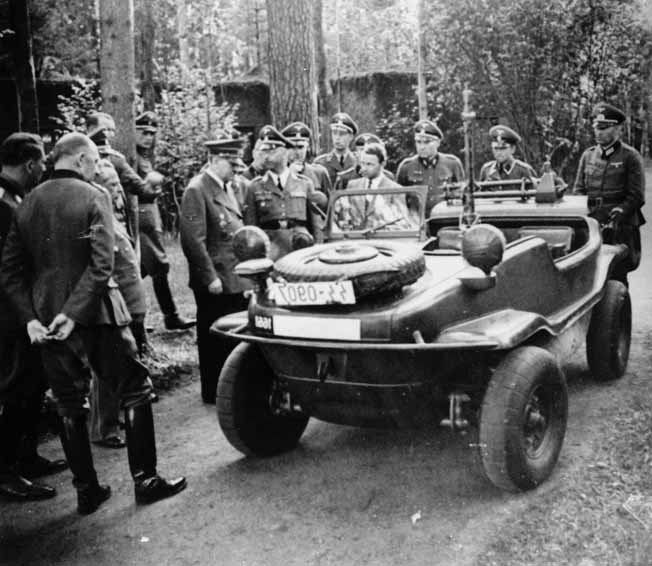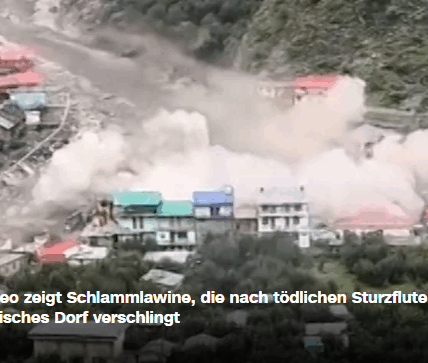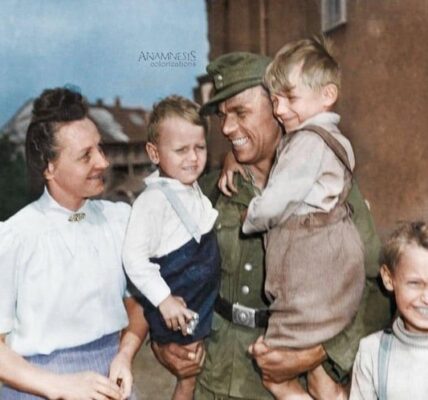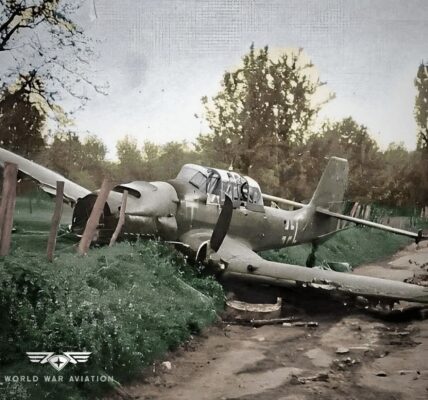


By Blaine Taylor
In the spring of 1940, as German forces swept through Western Europe, the famous automobile designer Dr. Ferdinand Porsche, inventor of the Volkswagen, or “people’s car,” was asked by the High Command to build a general-purpose vehicle for the upcoming campaign against the Soviet Union.
In April 1941, as the Balkan campaigns began, the Waffen-SS commissioned Porsche’s son, heir, and namesake, Dr. Ferry Porsche, to develop a similar vehicle. The result was the Kübelwagen, and a further development of this design was an amphibious version called the Schwimmwagen. A total of 150 all-wheel-drive amphibious vehicles were produced for testing and trials.
The development of the Schwimmwagen
The VW Kübelwagen and the Schwimmwagen shared few parts, but they shared the same rear-mounted, air-cooled four-cylinder boxer engine. However, the all-wheel drive was something special, as was its truly unique feature: a retractable water propeller at the rear of the subcompact frame.
The body of the water-based Kübelwagen consisted of a single, welded steel hull, more like a boat than a car, reinforced by crossbeams. Because the vehicle floated very low in the water, there were no doors to open or close. People simply climbed in and out of the vehicle.
A total of 14,276 Schwimmwagen were built between 1942 and 1944, and they saw service on both the Eastern and Western Fronts. After the war, the vehicle experienced a new heyday in Europe as a recreational vehicle, favored by duck hunters in swamps and marshes.
The Schwimmwagen reached a top speed of 80 km/h on land and 10 km/h in water. It featured an air-cooled, four-cylinder, overhead-valve boxer engine with a displacement of 1,131 cc and an output of 25 hp. It also featured a four-speed transmission, a folding three-blade propeller, four-wheel brakes, and a seamless, waterproof hull made of pressed steel with a monocoque construction.
Although there were competitors at first, the Schwimmer ultimately prevailed and became the only amphibious vehicle used by both the German Army and the Waffen-SS. Its biggest competitor was the Type 2SG, designed by Hannes Trippel, of which a thousand were built before production of all amphibious vehicles was discontinued in 1944.
The Porsche Design Bureau’s Type 128 Kübelwagen, the Schwimmer prototype, appeared in 1940. Thirty examples were built and delivered to the army for testing the following year. The boat-shaped body rested on the standard VW chassis. After approval by the SS leadership office of Major General Hans Jüttner, the Type 128 was improved as the Type 166 and entered series production in 1942.
The Schwimmwagen was designed not only as a water vehicle, but also as a replacement for the motorcycle reconnaissance vehicles that had proven their worth in the Western campaigns. Motorcycles had been introduced as a replacement for mounted cavalry. Ironically, despite the motorcycle, the horse made a late comeback in the East, simply because it was better suited to the terrain.
The production model of the Schwimmwagen Type 166 had a 40 cm shorter wheelbase and a 10 cm narrower width than its predecessor, the Type 128. The 1,130 cm long engine was the same as that of the Kübel (Bucket) of 1943 and had a draft of 77 cm. In addition to the Waffen-SS, these maneuverable vehicles were also used by the regular pioneer battalions of the German Army, the Luftwaffe field divisions under Reichsmarschall Hermann Göring, and the elite paratrooper troops of Luftwaffe General Kurt Student.
The early model: the Type 128 Schwimmer
On September 21, 1940, the first box-shaped Schwimmwagen appeared, which looked very similar to the Type 87 bucket and had welded doors. Decades after the war (from 1973 to 1976), a variant of this vehicle reappeared in the USA and Mexico as the Volkswagen “Thing.”
The Type 128 Schwimmer also featured the Kubel Type 87 engine, but with front-wheel drive, a limited-slip differential, watertight front wheel bearings, and front axle support bolts encased in rubber rings. The speedometer cable was routed through a watertight housing with rubber sleeves and metal protective caps. It also featured two three-leaf spring bars.
The Type 128 float-type gearbox also differed from other gearboxes. It featured easier-to-install rear axle drive shafts, double sealing of the half-shaft crown gear, a connection of the rear axle to the main body via sleeves and spring rods, and a different mounting and sealing of the rear shock absorbers. The brake cables were filled with grease and also watertight, but there were no grease nipples.
On November 1, 1940, the Schwimmwagen prototype was ready for testing by the Army Ordnance Office. The demanding tests on highways, country roads, off-road, and in water transport, for which it was originally designed, lasted until December 6.
The VW Schwimmer Type 128 consumed six liters of fuel per hour in the water. In December 1940, the Wehrmacht approved the construction of 100 more vehicles, and the Drauz company, later also Ambi-Budd, was commissioned to build the bodies. Further tests took place in the spring of 1941 before and during Operation Barbarossa on the Eastern Front. The Wehrmacht Training Office also conducted water trials on Lake Wunzdorf. The new Schwimmer vehicles passed their tests again.
A final Alpine test with three Type 128s took place in August 1941, when the Germans were achieving resounding victories in the East against the weakening Red Army. The mountain tests covered a total of 2,580 kilometers. The official report stated: “Driving on mountain trails in the high mountains under difficult conditions, such as on the Kitzbühler Horn, or under the worst conditions on the Rudnicker Alm near Watsching, which were sometimes muddy, rocky, very narrow, and steep, showed us like never before the exceptional off-road capability of the Type 128 with sensible driving. We drove on trails where no motor vehicle had ever been driven before, and the total weight was always almost half a ton.”
“The vehicle’s waterworthiness left nothing to be desired after its excellent off-road test runs, as it performed flawlessly in rivers at higher speeds than the other [competitor] vehicle.” On February 18, 1942, production of both the 128 and the 129 was discontinued in favor of the improved Type 166, which was introduced the following April.
Introduction of the Type 166
The first Type 166 was tested in March 1942 at the Max Eyth Reservoir near Stuttgart. Acceptance by the Ordnance Office of the Army High Command (OKW) took place on May 29. On June 6, 1942, exactly two years before D-Day in Normandy, the first batch of completed Type 166 models rolled off the assembly line. In July 1942, snow tests were conducted on the Grossglockner. At the end of 1942, Wehrmacht and SS units in the field received their reliable small floats.
The vehicle was so seaworthy that a committee of the Ordnance Office seriously tried to persuade Dr. Porsche to equip it with a green light on the starboard side and a red light on the port side to comply with international navigation regulations.
The Schwimmwagen was equipped with a pivoting MG-34 machine gun for protective armament. Four magazines were mounted on the right side of the fuselage, providing easy access to the gunner.
Dr. Ferry Porsche wrote in his 1976 memoirs, ” We at Porsche” : “This machine [the Type 166] could carry four people and differed from its predecessor, the Type 128, not only in size but also in details. It carried much less equipment… an anchor and similar equipment normally found in naval boats were deemed unnecessary… Its main purpose was to enable officers of vanguard units to move overland, ford rivers, and conduct reconnaissance from the water. In fact, officers used some of them as duck-hunting platforms! …
Our experience with the Type 166 amphibious vehicle during the Russian campaign was incredibly positive. This compact machine had no trouble navigating the same terrain as tanks! I can speak with some satisfaction, as I was responsible for the entire Kübelwagen production—both land and amphibious vehicles—from 1939 until the disaster in 1945.
By August [1941], the first prototype was ready for testing. I was asked to bring this car to Hitler’s headquarters for a demonstration, and he seemed pleased. … He spent a lot of time inspecting the vehicle and asked the most detailed questions … ‘I would like to ask you, by the way, to think about a serious problem. It concerns our soldiers in the East. They constantly have to fight mosquitoes, just as they do against the Russians. Couldn’t you develop a kind of mosquito net for this car to offer them protection while driving?’ Hitler asked.
At that very moment, one of the generals present, standing right next to Hitler, was bitten in the cheek by a mosquito. With astonishing speed, Hitler struck and killed the mosquito. Immediately, the blood it had sucked began to run down the general’s face. Hitler found this very funny. ‘Look!’ he said. ‘The first German general to shed blood in this war!'”
Officially designated as the Leichter Mannschaftswagen (Kfz 1/20) Type 166, it had a wheelbase of 2,000 mm, was 3,825 mm long, had an overall height of 1,615 mm, a width of 1,480 mm, a track center distance of 2,000 mm, a net weight of 890 kg, a ground clearance of 265 mm, a 24 hp engine, a displacement of 985/1 (131 cc on later models) and a fuel tank with a capacity of 50 liters.
In addition, the vehicle featured a five-speed transmission with two self-locking differentials, mechanical brakes, and independent suspension with torsion bars. Tire sizes were 5.25-16 and 200-12.
This raises the question of how the propeller system actually worked. The vehicle could jump into the water with a swift leap. Once there, the propeller was lowered below the water’s surface, connected to the drive shaft, and the boat-like vehicle glided smoothly to the other shore. Once there, the propeller was released from the drive shaft and manually pulled out of the water. The four-wheel drive was then reengaged, and the vehicle drove itself out of the water as soon as the front wheels touched solid ground. The vehicle’s rudder was controlled by turning the wheels to the right or left.
The legacy of the “boat on wheels”
In the truest sense of the word, the Schwimmwagen was a boat on wheels that also rolled on land, with a high-mounted exhaust system at the rear and a simple air intake grille behind the cockpit. According to author Keith Seume in VW Beetle , “The large engine cover was designed to prevent water from entering the engine compartment. The simple top could be folded down, but offered little protection when open. Even rudimentary fenders offered minimal protection. … This is considered one of the most versatile military vehicles ever built.”
The final word on this remarkable war vehicle comes from American author Walter Henry Nelson in his excellent 1965 work ” Small Wonder: The Amazing Story of the Volkswagen.” The British Army captured the VW factory in Wolfsburg in 1945 and was particularly fond of the float. “They held games in which they drove it at 40 mph from the quays into the Mittelland Canal, hit the water with a loud splash, and then drove the cars up and down the canal,” Nelson wrote.
The French wanted to confiscate some of the factory’s important butt-welding machines, but the British decided to stop them in a rather unusual way. They put their almost-drunk guests in floats and rode them along the canal, then suddenly turned off the bank and plunged into the water, flying across the surface at top speed and then landing with full force in the water.
An officer later recalled: “We gave the French a pretty wild ride in the water, too, and then by chance the plug of the bilge tank came out; our vessel just happened to sink!”
